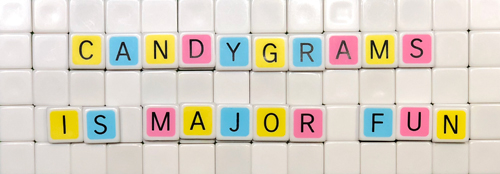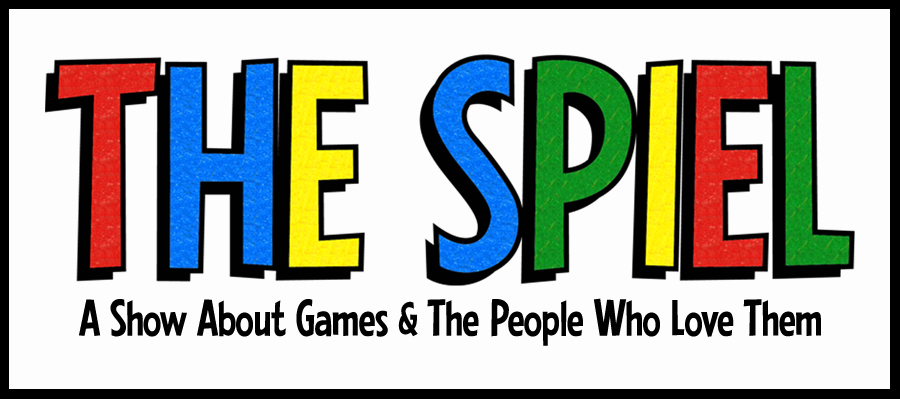Episode 291: Candygrams
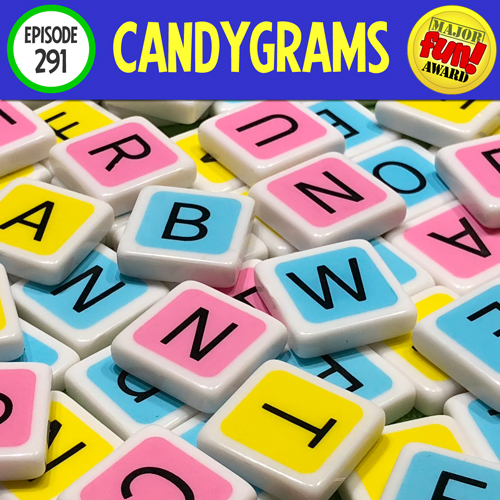
|
Release Date: Apr. 10 , 2018 |
Download: PDF |
|
Designer: Johnny Landers |
Publisher: Candygrams LLC |
|
2-4 pl | 15-20 min | ages 6+ | MSRP $25 |
|
Candygrams is a colorful crossword game that offers fun and challenging twists to a traditional word game.
Roll dice, build words from the colors rolled. Use all your tiles to win and reuse tiles already played, if you're clever.
Young players can play on one level and word nerds can appreciate it on another. The magic is both groups can enjoy playing together without the game bogging down.
This makes Candygrams a delight and most surely a delicious helping of Major Fun!
Written review continues after the break.
Candygrams Official Site | BGG | Buy

The Concept
Candygrams is a colorful crossword game that offers some fun and challenging twists to a traditional word game. Use letter tiles to create (and recreate) your own grid of words to win the game.
The Components
Candygrams comes with 111 really nice letter tiles. Each tile has a nice thickness and heft and is screen printed in one of three bright colors: pink, yellow and blue.

The game also comes with two large six sided dice. These dice have colored faces that match the colors of the tiles: 2 yellow, 2 pink and a 2 blue sides. To play, mix up the tiles face down and each player draws 25 tiles to his or her hand (called the candy shop).
Set 10 extra tiles face up in the middle. This is the Candy Jar. Now we're ready to begin!
The Mechanics
Well, almost ready! The first thing each player will do is create a starting word for his or her own personal crossword layout. Over the course of the game, you'll build from the base word up and down and across to form new words with new tiles. You will create your own personal free-form board.
The only rule with this starting word? It has to contain at least one of each different color tile.

Once everyone has a base word, the first round begins with someone rolling the dice.
Once the dice are rolled everyone plays together using the result of the dice. The colors rolled on the dice tell you which dice can be used to make words this round. If I roll pink and blue, this means those are the only color letters I can use. Yellow has to sit this one out.

This color rule applies to the letters you build off of on your crossword board. Using the example above, you have to build your new word off a blue or pink letter. You can add onto an existing word, branch off in a new direction, even create multiple words as long as all the tiles are played in a single line horizontally or vertically. But in each case this pesky color rule still applies.
The goal of the game is to play all 25 tiles first, so the longer the word you build each turn, the closer you are to victory. No scoring, no points. Just get all the tiles from your candy shop to your board.

What Sets This Game Apart
The color restrictions provided by the dice deserve some real love here. Instead of one rack of letter tiles, you really have Six different racks of tiles depending on how the dice come up. Blue - Pink, Blue- Yellow, Yellow - Pink involved two colors BUT it is also possible to roll doubles! So you may have a turn where you can only play just blue, pink or yellow!
On one hand, this may severely limit your options, depending on the mix of tiles in your candy shop. BUT whenever doubles are rolled, you can swap one tile from your hand with a tile in the Candy Jar. This means, as the dice come up with doubles you can slowly shift your hand away from troublesome letters.
As the game moves on, you may find a great word (or words) that use a ton of tiles but if the color dice dont cooperate, you may have to bide your time and hold onto those letters, hoping the right roll will come next round. A different kind of randomness. Not the randomness of drawing a bad rack of tiles. But randomness that requires patience and planning. You dont know how the dice will come up, so there's an element of hand management in play throughout the game.If you do not try to keep a bit of balance in your candy shop, you may find yourself with a a mix of tiles you know wont blend together. If you dont take this into account, you'll find yourself with a mix of tiles that wont blend together nicely into words and have to pass, waiting for doubles so you can swap out a tile.

It's not just what tiles you play but when you play them that matters!
Even where you play them matters! And this is what really sets Candygrams apart.
When you go to form your word each round, you have access to any tiles already on the board and played to your layout provided that removing them from the layout doesnt split the board and that all the words in your crossword are, well, still words! You cant take a tile and leave a string of gibberish!
This means that if you are clever about WHERE you play your tiles to the board, you still have access to them on later rounds. Using prefixes or suffixes that can be peeled off and have a word remain valid may give you many more options. And the number of options you keep open comes down to how cleverly you can build your words and your board.
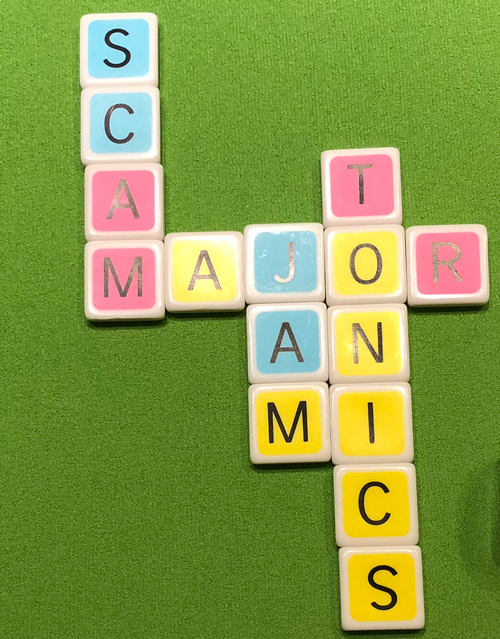
Here, I used the S from tonics (above) later in the game to make the word suds (below). Since tonic (singular) is still a valid word, I can peel off the S and use it again.
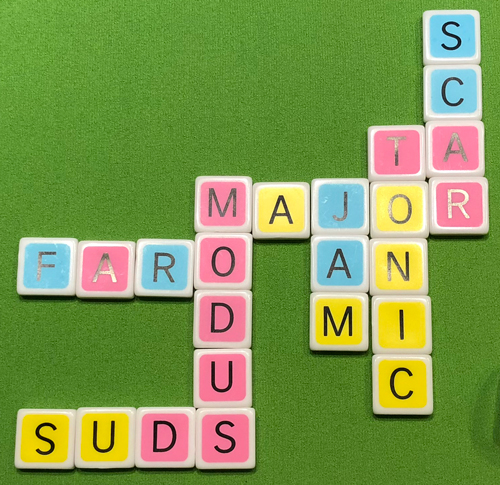
Using dice to create a new challenge each round and allowing players to use tiles already in play make decisions in Candygrams fun and different than most other word games.
Final Thoughts
Whenever we begin a discussion about word games, we have to address the 800 pound gorilla in the room: Scrabble. Since 1937, it has dominated and continues to dominate the market. And for good reason. It's an excellent game! That said, it has so thoroughly dominated the landscape and for such a long time, it is almost impossible to imagine a word game that isn't built from a foundation that starts with Scrabble. Can you think of many words games today that you wouldnt start by saying "It's like Scrabble, but....?" It's not impossible, but it's not easy! I'm no Scrabble hater at all but its success has has a collective effect on how we imagine word games. Scrabble has provided the boundaries and that means we end up with a LOT of games that are just way too similar to the original.
Enter Candygrams. Yes, you can definitely see it has a Scrabblicious foundation. BUT let's try the exercise I suggested above.
It's like Scrabble...
but you have dice
and the dice tell you what tiles you can use
and the dice tell you when you can swap tiles
and you build words on your own board
and you can use tiles already played to the board
and you 're not playing for points.
So, it's not one difference. It's many! This is no tweak. It may have started in the Scrabble chorus, but Candygrams has a clear voice – a voice that stands out from the crowd.
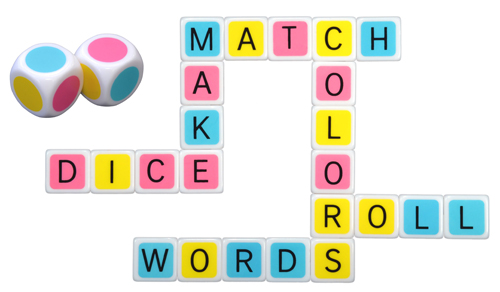
The last thing I want is for my praise of these subtleties to make Candygrams seem too complex. It's truest strength lies in its simplicity.
The game really is roll dice, build words from the colors rolled. Use all your tiles to win and reuse tiles already played, if you're clever.
Young players can play on one level and word nerds can appreciate it on another. But the magic is both groups could enjoy playing together
That makes Candygrams a delight and most surely a delicious helping of Major Fun!
***
